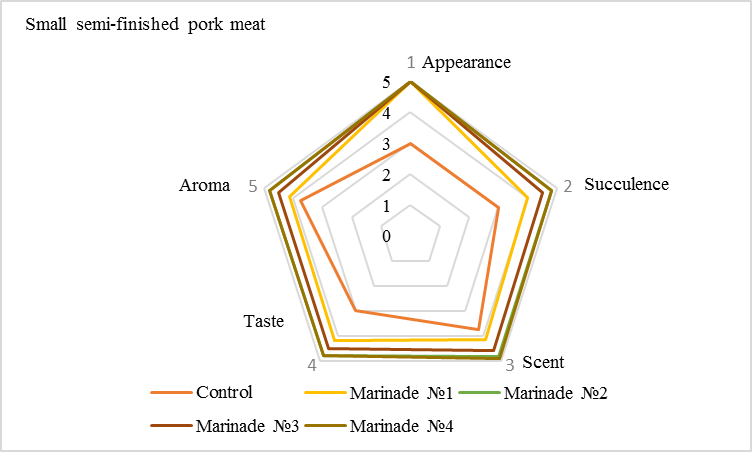TECHNOLOGY OF MARINED GAME SEMI-FINISHED MEAT WITH AN ACCENT OF ELEGANCE AND FUNCTIONALITY
DOI:
https://doi.org/10.15421/jchemtech.v30i4.268176Keywords:
wild boar meat; venison; beef; pork; semi-finished products; marinade; heat treatment; quality of food products.Abstract
The aim of the work was to theoretically substantiate and experimentally establish the influence of the marinating process of small pieces of semi-finished products from animal meat of various species using different methods of heat treatment on a complex of technological, microbiological and organoleptic indicators of the quality of the finished product. The aim of the work was to theoretically justify and experimentally establish the influence of the marinating process of small pieces of semi-finished products from animal meat of various species with the use of various methods of heat treatment on a complex of technological, microbiological and organoleptic indicators of the quality of finished products. To achieve the goal, the task was set: to analyze the chemical composition of the meat of wild animals in comparison with the traditional meat of agricultural animals; choose raw materials for making marinades, determine physico-chemical and functional-technological indicators of small semi-finished products after marinating; to study the effect of heat treatment on the quality of ready-made small semi-finished products, to determine the safety indicators of semi-finished products during storage. The main goal of the research was to improve the production technology of small semi-finished products from wild boar meat; choose raw materials for making marinades that soften meat; to determine the physico-chemical and functional-technological indicators of semi-finished products; to investigate the impact of the possibility of using different methods of heat treatment in the technology of marinated semi-finished products from traditional raw materials of beef and pork meat in comparison with the meat of wild animals; set processing modes; to determine the safety indicators of the developed small semi-finished products in the storage process. Analytical and experimental methods of analysis were used to conduct research: organoleptic, physico-chemical, functional-technological, microbiological and instrumental with the use of modern computer technology equipment. In the work, the chemical composition and functional and technological indicators of wild boar meat were investigated in comparison with traditional raw materials and its advantages were established, raw materials were selected for the production of marinades; the physico-chemical and functional-technological indicators of semi-finished products are determined; the influence of the main methods of heat treatment on the quality of finished products is studied. Based on the analysis and generalization of theoretical data, the results of comprehensive research, it was established that in terms of chemical composition and functional and technological properties, wild boar meat is superior to farm animal meat. The best organoleptic characteristics of the finished product were obtained on the basis of successfully selected optimal recipes of the marinade, due to which certain properties (taste, color, aroma) were given to small-sized semi-finished products. The main task of the technology is the maximum preservation of valuable components of raw materials while bringing the product to culinary readiness, during the research it was found that the best result was obtained when processing small-sized semi-finished products in a combi oven at t = 220−2600С, φ=15% for 8−10 minutes. According to the results of the conducted research, microbiological stability was established - the conditions for the growth of beneficial microflora and its influence on the ripening processes due to the organic acids of the marinades - increased stability of the small semi-finished product, which ensures the preservation of the product quality for 15 days in vacuum packaging.

Downloads
Published
Issue
Section
License
Copyright (c) 2023 Oles Honchar Dnipro National University

This work is licensed under a Creative Commons Attribution 4.0 International License.
- Authors reserve the right of attribution for the submitted manuscript, while transferring to the Journal the right to publish the article under the Creative Commons Attribution License. This license allows free distribution of the published work under the condition of proper attribution of the original authors and the initial publication source (i.e. the Journal)
- Authors have the right to enter into separate agreements for additional non-exclusive distribution of the work in the form it was published in the Journal (such as publishing the article on the institutional website or as a part of a monograph), provided the original publication in this Journal is properly referenced
- The Journal allows and encourages online publication of the manuscripts (such as on personal web pages), even when such a manuscript is still under editorial consideration, since it allows for a productive scientific discussion and better citation dynamics (see The Effect of Open Access).

